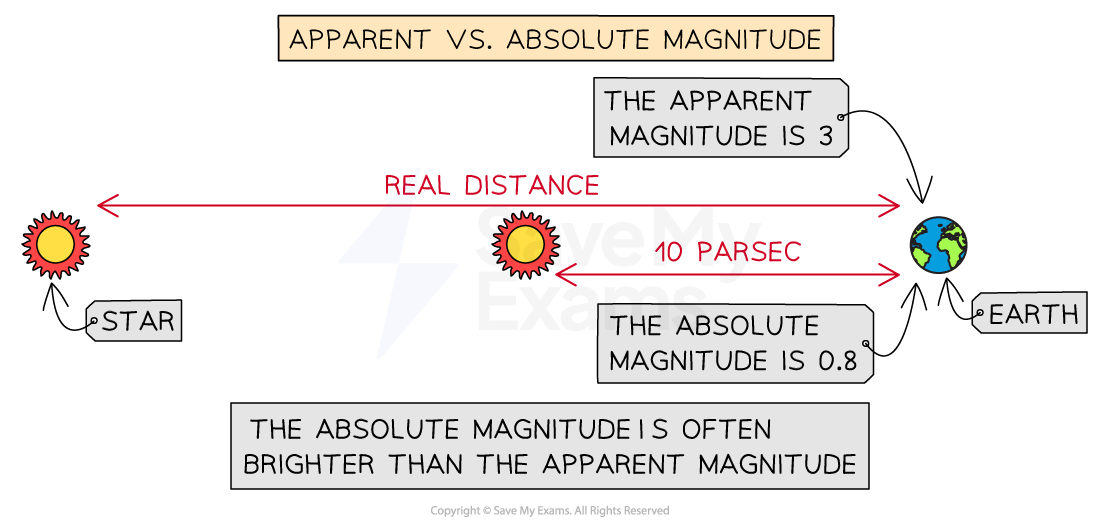Absolute Magnitude (AQA A Level Physics): Revision Note
Exam code: 7408
Absolute Magnitude
The inherent brightness, or intensity of a star, as seen to the naked eye on Earth, depends on its:
Luminosity
Distance from Earth
If two different stars have the same apparent magnitude it does not necessarily mean they emit the same amount of light or are the same size
Therefore, it's useful to compare how bright they would appear to be if they were exactly the same distance from the Earth
This is where the concept of absolute magnitude comes in
The absolute magnitude of a star is defined as:
The apparent magnitude it would have if it were observed from a distance of 10 parsecs away from Earth
Since most stars are much further than 10 parsecs away, they would appear brighter if observed at a distance of 10 parsecs
Apparent vs. absolute magnitude

The absolute magnitude is often brighter than the apparent magnitude
For example, a real bright star very far away would have the same apparent magnitude as a dim star close by
However, their absolute magnitudes will be different
This means that:
Absolute and apparent magnitudes are measured on the same logarithmic scale
Values of absolute magnitudes are more negative than their associated apparent magnitudes
The relationship between the apparent magnitude, absolute magnitude and distance of a star from Earth is:
Where:
M = absolute magnitude
m = apparent magnitude
d = distance of the star from Earth (measured in parsecs)
The difference between apparent and absolute magnitude
is known as the distance modulus
This is useful for quickly determining the relative distance of a star
Distance modulus is negative for stars closer than 10 pc
Distance modulus is positive for stars further away than 10 pc
Worked Example
The table shows some information about four stars in the constellation of Pegasus.
Star | Apparent magnitude | distance / ly |
Algenib | 2.84 | 390 |
Enif | 2.39 | 690 |
Markab | 2.49 | 140 |
Scheat | 2.42 | 200 |
(a) State which of the stars in the table is the brightest on the absolute magnitude scale.
(b) State which of the stars in the table is the dimmest on the absolute magnitude scale.
(c) Calculate the absolute magnitude of Algenib.
Answer:
Part (a)
The brightest on the absolute magnitude scale is...
All have similar values of apparent magnitude
Therefore, furthest = brightest = Enif
Part (b)
The dimmest on the absolute magnitude scale is...
All have similar values of apparent magnitude
Therefore, closest = dimmest = Markab
Part (c)
Calculate the absolute magnitude of Algenib:
Step 1: List the known quantities
Apparent magnitude of Algenib,
= 2.84
Distance to Algenib,
= 390 ly
1 pc = 3.26 ly (from data booklet)
Step 2: Convert the distance into parsecs
Distance to Algenib: = 119.6 pc
Step 3: Rearrange the magnitude equation and calculate the absolute magnitude
Absolute magnitude:
Examiner Tips and Tricks
Be specific in the language you use when comparing magnitudes - a 'bigger' magnitude could either mean brighter (greater intensity) or dimmer (bigger number)
To avoid confusion, make sure to say 'brighter' or 'dimmer' magnitudes rather than larger or smaller.
You must be comfortable with working with logs to manipulate this equation.

Unlock more, it's free!
Did this page help you?